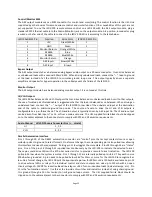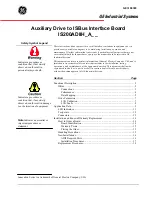
Page 54
Pin
Description
1
Control 1. Pulse low to select format 1 (COAX1). Pulses low when format 1 selected.
2
Control 2. Pulse low to select format 2 (COAX2). Pulses low when format 2 selected.
3
Control 3. Pulse low to select format 3 (TOSLINK). Pulses low when format 3 selected.
4
Control 4. Pulse low to select format 4 (16 Channel Digital). Pulses low when format 4 selected.
5
Control 5. Pulse low to select format 5 (User 1). Pulses low when format 5 selected.
6
Control 6. Pulse low to select format 6 (User 2). Pulses low when format 6 selected.
7
Control 7. Pulse low to select format 7 (8 Channel Analog). Pulses low when format 7 selected.
8
Control 8. Pulse low to select format 8 (Non/Sync). Pulses low when format 8 selected.
9
Control 9. Pulse low to select format 9 (AUX). Pulses low when format 9 selected.
10
Control 10. Pulse low to select format 10 (MIC). Pulses low when format 10 selected.
11
Mute. Pulse low to toggle the mute state of the system.
12
Automation Return. Return control and status signals here.
13
+5V at 100mA to drive external indicators.
14
Status 1. Low when format 1 (COAX1) is selected.
15
Status 2. Low when format 2 (COAX2) is selected.
16
Status 3. Low when format 3 (TOSLINK) is selected.
17
Status 4. Low when format 4 (16 Channel Digital) is selected.
18
Status 5. Low when format 5 (USER 1) is selected.
19
Status 6. Low when format 6 (USER 2) is selected.
20
Status 7. Low when format 7 (8 Channel Analog) is selected.
21
Status 8. Low when format 8 (NON/SYNC) is selected.
22
Status 9. Low when format 9 (AUX) is selected.
23
Status 10. Low when format 10 (MIC) is selected.
24
Mute Status. Low when the system is muted.
25
Unused. Make no connection to this pin.
RS-232 Interface
The RS-232 interface appears on a DE9F connector on the rear panel. The connector is wired as a DCE device. A
command interpreter accepts ASCII commands (described in Appendix B) over the RS-232 and Ethernet interfaces.
The RS-232 port operates at 38.4kbps, 8N1 (8 data bits, no parity, 1 stop bit), hardware handshake. In most
situations, no handshake is required, and the RTS and CTS pins can be left open. The USL supplied ferrite block
should be clipped on to the cables adjacent to the connectors to comply with FCC and CE emission requirements.
Pin
Description
1
DCD – Internally connected to pins 4 and 6. Does not need to be connected in most cases.
2
TXD – The JSD-100 transmits data on this pin.
3
RXD – The JSD-100 receives data on this pin.
4
DTR – Internally connected to pins 1 and 6. Does not need to be connected in most cases.
5
GND – Signal ground.
6
DSR – Internally connected to pins 1 and 4. Does not need to be connected in most cases.
7
CTS – The JSD-100 holds off transmitting data if the device connected to the JSD-100 drives this
pin low. Data transmission is resumed when this pin is driven high. The pin is pulled high in the
JSD-100 so the pin can be left open in most cases.
8
RTS – The JSD-100 drives this pin low when it is not ready to receive data and drives it high when
it is ready to receive data. In most cases this pin can be left open.
9
RI – The JSD-100 provides a current limited (900mA) +5V to drive external equipment on this pin.
Summary of Contents for JSD-100
Page 12: ...Page 12...















































